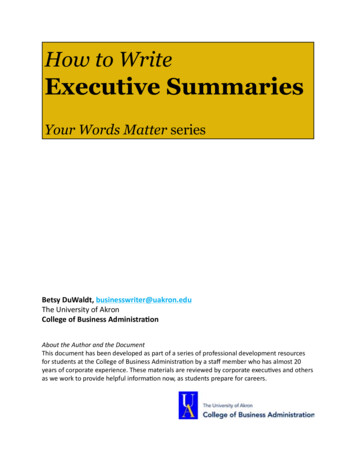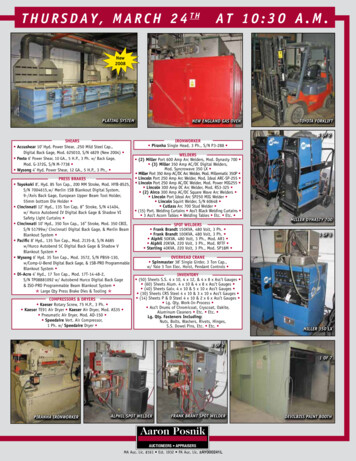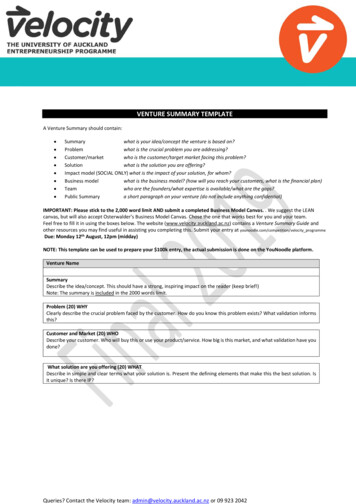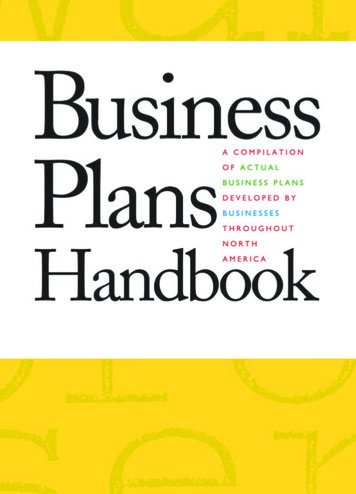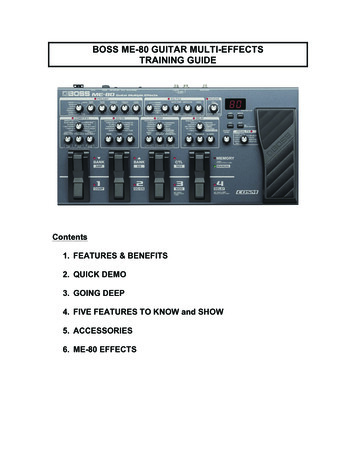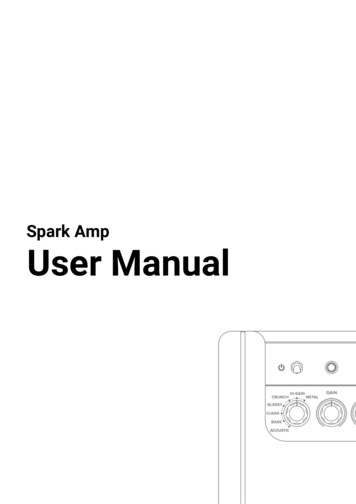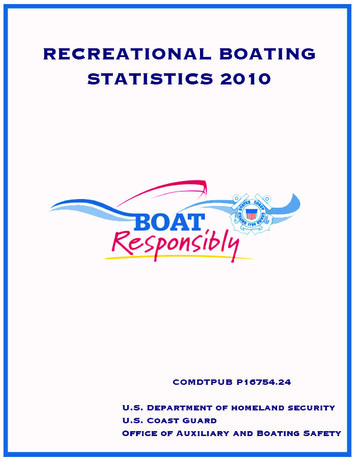
Transcription
Introduction & Executive SummaryTable of ContentsIntroduction2010 Executive SummaryMission and Strategic Plan of the National Recreational Boating Safety ProgramOverview of StatisticsChanges to the PublicationAccident Reporting as Required by Federal LawCasualty and Accident Reporting Guidelines“Reportable” Boating Accidents“Non-Reportable” Boating AccidentsUse of Statistics6-7888-99-10101011-1213Accident Causes and Conditions Tables with ExplanationTable 4Percent of Accidents that are Fatal by MonthFigure 1Percent of Accidents that are Fatal by Month (graph)Table 5Primary Contributing Factor of Accidents & CasualtiesTable 6Machinery & Equipment Primary Contributing Factor of Accidents & CasualtiesFigure 2Primary Contributing Factor of Accidents (graph)Figure 3Primary Contributing Factor of Deaths (graph)Figure 4Primary Contributing Factor of Injuries (graph)Table 7Number of Vessels in Accidents by Vessel Type & Primary Contributing FactorTable 8Alcohol Use as a Contributing Factor in Accidents & Casualties by State 06-10Table 9Vessel Operation at the Time of AccidentTable 10Vessel Activity at the Time of AccidentTable 11Weather & Water ConditionsTable 12Time Related DataTable 13Vessel InformationTable 14Rental Status of Vessels Involved in AccidentsTable 15Number & Percentage of Deaths by Vessel LengthFigure 5Number of Deaths by Vessel Length dent Types Tables with ExplanationTable 16Accident, Vessel & Casualty Numbers by Primary Accident TypeTable 17Frequency of Accident Types in Accidents & Casualties NationwideTable 18Number of Vessels in Accidents by Vessel Length & Primary Accident TypeTable 19Number of Vessels in Accidents by Vessel Type & Primary Accident TypeTable 20Number of Vessels in Accidents by Primary Accident Type & Propulsion TypeTable 21Number of Vessels in Accidents by Primary Accident Type & Engine Type32-333435-3839404141Operator/Passenger Information Tables with ExplanationTable 22Operator InformationTable 23Number of Deaths by Type of Operator Boating InstructionFigure 6Number of Deaths by Known Operator Instruction (graph)Table 24Number of Deaths by Vessel TypeFigure 7Number of Deaths by Vessel Type (graph)Table 25Number of Deceased Victims by Age & Vessel TypeTable 26Number of Injured Victims by Age & Vessel TypeTable 27Nature of Primary Injury Type by Area of Injury434445454646474849Casualty Summary Data Tables with ExplanationFigure 8Deaths, Injuries & Accidents by Year, 1996-2010 (graph)Table 28Deaths, Injuries & Accidents by Year, 1996-2010Table 29Accident, Casualty & Damage Data by StateFigure 9Distribution of 2010 Deaths by State Expressed as a PercentageFigure 10Annual Recreational Boating Fatality Rates 1996-2010Table 30Annual Recreational Boating Fatality Rates 1996-201051525253545555Recreational Boating Statistics 20103
Introduction & Executive SummaryFigure 11Table 31Table 32Table 33Table 34States Coded by their 2010 Fatality RateFive-year Summary of Selected Accident Data by StateNumber of Accidents by Primary Accident Type & StateNumber of Injured Victims by Primary Injury & Vessel TypeNumber of Fatal Victims by Life Jacket Wear, Cause of Death, & Vessel Type565758-596060Registration Data Tables with ExplanationTable 35Recreational Vessels Registered by Year, 1980-2010Figure 12Recreational Vessels Registered by Year, 1980-2010 (graph)Table 36Recreational Vessel Registration by Length & Means of PropulsionTable 37Recreational Vessel Registration Data by StateFigure 13Distribution of 2010 Recreational Vessel Registration by State626363646566Boating Accident Report FormGlossary of TermsGlossary of State Codes67-7273-7677Recreational Boating Statistics 20104
Introduction & Executive SummaryList of TablesTable 1Table 2Table 3Table 4Table 5Table 6Table 7Table 8Table 9Table 10Table 11Table 12Table 13Table 14Table 15Table 16Table 17Table 18Table 19Table 20Table 21Table 22Table 23Table 24Table 25Table 26Table 27Table 28Table 29Table 30Table 31Table 32Table 33Table 34Table 35Table 36Table 372010 Executive SummaryNews Media Accidents and CasualtiesNon-Reportable Scenarios with their Casualty CountPercent of Accidents that are Fatal by MonthPrimary Contributing Factor of Accidents & CasualtiesMachinery & Equipment Primary Contributing Factor of Accidents & CasualtiesNumber of Vessels in Accidents by Vessel Type & Primary Contributing FactorAlcohol Use as a Contributing Factor in Accidents & Casualties by State 06-10Vessel Operation at the Time of AccidentVessel Activity at the Time of AccidentWeather & Water ConditionsTime Related DataVessel InformationRental Status of Vessels Involved in AccidentsNumber and Percentage of Deaths by Vessel LengthAccident, Vessel & Casualty Numbers by Primary Accident TypeFrequency of Accident Types in Accidents & Casualties NationwideNumber of Vessels in Accidents by Vessel Length & Primary Accident TypeNumber of Vessels in Accidents by Vessel Type & Primary Accident TypeNumber of Vessels in Accidents by Primary Accident Type & Propulsion TypeNumber of Vessels in Accidents by Primary Accident Type & Engine TypeOperator InformationNumber of Deaths by Type of Operator Boating InstructionNumber of Deaths by Vessel TypeNumber of Deceased Victims by Age & Vessel TypeNumber of Injured Victims by Age & Vessel TypeNature of Primary Injury Type by Area of InjuryDeaths, Injuries & Accidents by Year, 1996-2010Accident, Casualty & Damage Data by StateAnnual Recreational Boating Fatality Rates 1996-2010Five-year Summary of Selected Accident Data by StateNumber of Accidents by Primary Accident Type & StateNumber of Injured Victims by Primary Injury & Vessel TypeNumber of Fatal Victims by Life Jacket Wear, Cause of Death & Vessel TypeRecreational Vessels Registered by Year, 1980-2010Recreational Vessel Registration by Length & Means of PropulsionRecreational Vessel Registration Data by 45464748495253555758-596060636465List of FiguresFigure 1Figure 2Figure 3Figure 4Figure 5Figure 6Figure 7Figure 8Figure 9Figure 10Figure 11Figure 12Figure 13Percent of Accidents that are Fatal by MonthPrimary Contributing Factor of AccidentsPrimary Contributing Factor of DeathsPrimary Contributing Factor of InjuriesNumber of Deaths by Vessel LengthPercent of Deaths by Known Operator InstructionNumber of Deaths by Vessel TypeDeaths, Injuries & Accidents by Year, 1996-2010Distribution of 2010 Deaths by State Expressed as a PercentageAnnual Recreational Boating Fatality Rates 1996-2010States Coded by their 2010 Fatality RateRecreational Vessels Registered by Year, 1990-2010Distribution of 2010 Recreational Vessel Registration by StateRecreational Boating Statistics 2010172021223045465254555663665
Introduction & Executive Summary2010 EXECUTIVE SUMMARY In 2010, the Coast Guard counted 4604 accidents that involved 672 deaths,3153 injuries and approximately 35.5 million dollars of damage to property as aresult of recreational boating accidents. The fatality rate was 5.4 deaths per 100,000 registered recreational vessels.This rate represents a 6.9% decrease from last year’s fatality rate of 5.8deaths per 100,000 registered recreational vessels. Compared to 2009, the number of accidents decreased 2.66%, the numberof deaths decreased 8.70% and the number of injuries decreased 6.10%. Almost three-fourths of all fatal boating accident victims drowned, and of those,eighty-eight (88) percent were not reported as wearing a life jacket. Only nine percent of deaths occurred on boats where the operator had receivedboating safety instruction. Only six percent of deaths occurred on vessels where theoperator had received boating safety instruction from a NASBLA-approved courseprovider. Eight out of every ten boaters who drowned were using vessels less than 21 feet inlength. Operator inattention, improper lookout, operator inexperience, excessive speed, andalcohol rank as the top five primary contributing factors in accidents. Alcohol use is the leading contributing factor in fatal boating accidents; it was listedas the leading factor in 19% of the deaths. Twenty-one children under age thirteen lost their lives while boating in 2010. 42% ofthe children who died in 2010 died from drowning. 44% of those who drowned werewearing a life jacket even though only half of them were required to do so by statelaw. The most common types of vessels involved in reported accidents were openmotorboats (46%), personal watercraft (20%), and cabin motorboats (14%). The 12,438,926 recreational vessels registered by the states in 2010 represent a2.2% decrease from last year when 12,721,541 recreational vessels were registered.Recreational Boating Statistics 20106
Introduction & Executive SummaryTable 1 2010 EXECUTIVE SUMMARYTOP FIVE PRIMARY ACCIDENT TYPESAccident RankAccident TypeNumber of Accidents12345Collision with Recreational VesselCollision with Fixed ObjectFlooding/SwampingSkier MishapCapsizing1088456448447335Number ofDeaths64387215180Number ofInjuries747332158471199VESSEL TYPES WITH THE TOP CASUALTY NUMBERSOtherTotalCasualty RankType of BoatDrowningsTotal Injuries Total CasualtiesDeathsDeathsOpen Motorboat213112325164419691Personal anoe/Kayak12813141962374Pontoon254291211505LIFE JACKET WEAR BY TOP FIVE KNOWN CAUSES OF DEATHLife JacketKnown CauseNumber ofCause of Deathof Death RankDeathsWornNot WornUnknown if worn12345DrowningTraumaCardiac ArrestHypothermiaCarbon Monoxide Poisoning484123151165749850395596653215101TOP TEN KNOWN PRIMARY CONTRIBUTING FACTORS OF ACCIDENTSAccident Rank12345678910Contributing FactorOperator InattentionImproper LookoutOperator InexperienceExcessive SpeedAlcohol UseForce of Wave/WakeHazardous WatersMachinery FailureRules of the RoadWeatherRecreational Boating Statistics 2010Number of Accidents759375358337330272265257211209Number ofDeaths491733181265100101641Number ofInjuries457266265324293252156752021027
Introduction & Executive SummaryMission and Strategic Plan of the National Recreational Boating Safety ProgramThe mission of the National RBS Program is “to ensure the public has a safe, secure, and enjoyable recreational boating experience by implementing programs that minimize the loss of life, personal injury,and property damage while cooperating with environmental and national security efforts”.The Strategic Plan of the National Recreational Boating Safety Program delineates the Program’seleven objectives to reduce casualties which include 1) tracking and increasing the number of educatedboaters; 2) increasing boating safety messages to target audiences; 3) increasing on-the-water boatinginstruction; 4) studying and increasing life jacket wear rates; 5) increasing knowledge of and compliancewith navigation rules; 6) decreasing boating under the influence; 7) decreasing the number of defectivevessels; 8) increasing boater compliance with vessel carriage requirements; 9) increasing the accuracyand reporting rates of reportable accidents; 10) conducting research and development of boating safetyinitiatives; and 11) measuring the effectiveness of non-profit organization grants. To view the StrategicPlan of the Program, please visit the Office’s website at http://www.uscgboating.org.Overview of StatisticsThis report contains statistics on registered recreational vessels and boating accidents during calendaryear 2010. Data used to compile the recreational boating accident statistics come from three sources: Boating Accident Report data forwarded to the Coast Guard by states with an approvedcasualty reporting system; and Reports of Coast Guard investigations of fatal boating accidents that occurred on watersunder Federal jurisdiction. Recreational boating accident investigation data are used if submitted to the Coast Guard and are relied on as much as possible to provide accurate accident statistics. In the absence of investigation data, information is collected from the accident reports filed by boat operators; and. Reports received from news media sources that the Coast Guard did not receive investigative data on by the state. The following table reflects the number of accidents, deaths, injuries, and losses of vessels that were captured in news media sources that met reportingrequirements for which the Coast Guard did not receive a report:NationallyTable 2 NEWS MEDIA ACCIDENTS AND CASUALTIESAccidentsDeathsInjuriesLosses of vessels56114613Damages 3,252,430Changes to the PublicationSome of the tables in this edition of the Statistics have changed because of alterations to the content onthe Coast Guard’s Boating Accident Report (BAR) form. One of the most dramatic changes lies in thecause categories. “Passenger/skier behavior” and “careless/reckless operation” were removed from thelatest BAR form because it was believed that the public would not report a negative behavior aboutthemselves. Since these categories were removed from the Coast Guard form, they will not be reportedin the national publication. For those jurisdictions that did not use the Coast Guard form to collect information and still used passenger/skier behavior and careless/reckless operation as a cause, the CoastGuard coded their cause according to the choices on the Coast Guard BAR form. An example of a casewhere the Coast Guard was able to code one of these causes to one available on the Coast Guard formis as follows: if a jurisdiction had selected “passenger/skier behavior” to describe an accident where anoccupant stood up in a canoe which led to the capsizing of the vessel, the Coast Guard coded thiscause as “improper loading” instead of “passenger/skier behavior”. An example of a case where theCoast Guard was not able to code one of these causes to a cause available on the Coast Guard form isas follows:Recreational Boating Statistics 20108
Introduction & Executive Summarya passenger on a vessel became injured while jumping out of a vessel while it was in motion. In thiscase, the Coast Guard coded the accident as “other” and captured “passenger/skier behavior” in the“other accident cause” category. “Careless/reckless operation” was likewise coded such that when applicable, it was coded as “Rules of the Road”. In other cases, the cause was coded as “other”.The second change to the tables is the removal of Table 24, Life Jacket Information. Part of this tablewas removed because the Coast Guard no longer collects life jacket carriage equipment information inthe same manner. The remaining part of this table was removed because the information in it was already presented in another table (Table 34).The third change to the tables in this edition is the merger of Tables 17 and 18, which address the seriesof events of accidents. An accident can be coded with up to three standardized fields that describe theorder in which events occurred in an accident. Table 17 provided a snapshot of accident types with acasualty count for the latest five years of data whereas Table 18 provided a snapshot of the frequency ofevents in accidents with a resulting casualty count. Because the Coast Guard considers all events in aregulatory study, the Office decided that it would be important to present this information for public use.Thus, Table 17 now provides the frequency of accident events with a casualty count for the latest fiveyears of data.The fourth change is the removal of the section on “speed” from Table 13. This section was removedbecause the Coast Guard no longer collects information about speed on the BAR form.The final major change was the addition of a table to describe injuries. With the implementation of thelatest Coast Guard BAR form, the injury section was reorganized to focus on two fields, the nature ofmost serious injury and the body part of the most serious injury. Thus, a crosstab table (Table 27 - Nature of Primary Injury Type by Area of Injury ) was created to present the types of injuries by area of injury.Accident Reporting as Required by Federal LawUnder federal regulations (33 CFR Part 173; Subpart C – Casualty and Accident Reporting) the operatorof any numbered vessel that was not required to be inspected or a vessel that was used for recreationalpurposes is required to file a BAR when, as a result of an occurrence that involves the vessel or itsequipment:1. A person dies; or2. A person disappears from the vessel under circumstances that indicate death or injury; or3. A person is injured and requires medical treatment beyond first aid; or4. Damage to vessels and other property totals 2,000 or more; or5. There is a complete loss of any vessel.If the above conditions are met, the federal regulations state that the operator or owner must report theiraccident to a state reporting authority, abbreviated in this publication as “state”. The reporting authoritycan be either the state where the accident occurred, the state in which the vessel was numbered, or, ifthe vessel does not have a number, the state where the vessel was principally used. The owner mustsubmit the report if the operator is deceased or unable to make the report.The regulations also state the acceptable length of time in which the accident report must be submittedto the reporting authority. Boat operators or owners must submit:1. Accident reports within 48 hours of an occurrence if:a. A person dies within 24 hours of the occurrence; orb. A person requires medical treatment beyond first aid; orc. A person disappears from the vessel.2. Accident reports within 10 days of an occurrence if there is damage to the vessel/property only.Recreational Boating Statistics 20109
Introduction & Executive SummaryThe minimum reporting requirements are set by Federal regulation, but states are allowed to have morestringent requirements. For example, some states have a lower threshold for reporting damage to vessels and other property.Federal Regulations (33 CFR 174.121) require accident report data to be forwarded to Coast GuardHeadquarters within 30 days of receipt by a state.The statistics in this publication cover boating accidents reported on waters of joint federal and state jurisdiction and exclusive state jurisdiction. Most states use Boating Accident Report forms that are similarto the Coast Guard form. A copy of the Coast Guard BAR form used for this report is on pages 67-72.This Coast Guard form was approved by the Office of Management and Budget in the summer of 2008.2009 was the first year that the form was used for data collection on a national basis.Casualty and Accident Reporting GuidelinesCasualty and accident reporting applies to each “vessel” used by its operator for recreational purposesor vessels that are required to be numbered and are not subject to inspection.The term “vessel” includes every description of watercraft or other artificial contrivance used, or capableof being used, as a means of transportation on the water. Terms used to describe the various types ofwatercraft are: airboat, auxiliary sailboat, cabin motorboat, canoe, houseboat, inflatable boat, kayak,open motorboat, personal watercraft, pontoon boat, raft, rowboat, and sailboat. Unmodified inner tubeshave not been determined to be “vessels” to date and thus any accident that only involves an unmodified inner tube has not been included in the statistics in the main body of this report.“Reportable” Boating AccidentsA vessel is considered to be involved in a “boating accident” whenever a death, missing person, personal injury, property damage, or total vessel loss results from the vessel's operation, construction, seaworthiness, equipment, or machinery.The following are examples of accident types that are used in this report: Grounding, capsizing, sinking, or flooding/swamping Falls in or overboard a vessel Persons ejected from a vessel Fire or explosions that occur while underway and while anchored, moored or docked if the fire resulted from the vessel or vessel equipment. Water-skiing or other mishap involving a towable device Collision with another vessel or object Striking a submerged object A person struck by a vessel, propeller, propulsion unit, or steering machinery Carbon monoxide exposure Electrocution due to stray current related to a vessel Casualties while swimming from a vessel that is not anchored, moored or docked. Casualties where natural causes served as a contributing factor in the death of an individual but thedetermined cause of death was drowning. Casualties from natural phenomena such as interaction with marine life (i.e. leaping sturgeoncauses casualty to person) and interaction with nature (i.e. mountain side falls onto vessel causingcasualties). Casualties where a person falls off an anchored vessel.Recreational Boating Statistics 201010
Introduction & Executive Summary“Non-Reportable” Boating AccidentsNot every occurrence involving a vessel is considered within the scope of the National RecreationalBoating Safety Program. The following occurrences involving a vessel may be required to be reported tothe state, but for statistical purposes are excluded from this report and are considered “non-reportable”boating accidents: A person dies, is injured, or is missing as a result of self-inflicted wounds, alcohol poisoning,gunshot wounds, or the ingestion of drugs, controlled substances or poison.A person dies, is injured, or is missing as a result of assault by another person or personswhile aboard a vessel.A person dies or is injured from natural causes while aboard a vessel.A person dies, is injured, or is missing as a result of jumping, diving, or swimming for pleasure from an anchored, moored or docked vessel.A person dies, is injured, or is missing as a result of swimming to retrieve an object or a vessel that is adrift from its mooring or dock, having departed from a place of inherent safety,such as the shore or pier.Property damage occurs or a person dies, is injured, or is missing while preparing a vesselfor launching or retrieving and the vessel is not on the water and capable / ready for its intended use.Property damage occurs or a person dies, is injured, or is missing as a result of a fire onshore or a pier that spreads to a vessel or vessels.Property damage occurs to a docked or moored vessel or a person dies, is injured, or ismissing from such a vessel as a result of storms, or unusual tidal or sea conditions; or whena vessel gets underway in those conditions in an attempt to rescue persons or vessels.Property damage occurs to a docked or moored vessel due to lack of maintenance on thevessel or the structure to which it was moored.Property damage occurs to a docked or moored vessel due to theft or vandalism.Property damage occurs to, a person dies or is injured on, or a person is missing from a non-propelled houseboat or other vessel used primarily as a residence when such a vessel isnot underway.Casualties that result from falls from or on docked vessels or vessels that are moored to apermanent structure.Casualties that result from a person climbing aboard an anchored vessel from the water orswimming near an anchored vessel.Fire or explosions on anchored, docked or moored boats where the cause of the fire wasnot attributed to the vessel or vessel equipment.Casualty or damage that results when the vehicle used for trailering the vessel fails.Casualties or damage that occur during accidents that only involve unmodified inner tubes.Casualties or damage that occur when the only vessel(s) involved are being used solely forgovernmental, commercial or criminal activity.Casualties or damage that occur when the only vessel(s) involved are not numbered andare being used exclusively for racing.Casualties or damage that occur when the only vessel(s) involved are foreign vessels andthus not subject to U.S. federal reporting requirements.Recreational Boating Statistics 201011
Introduction & Executive SummaryTable 3 Non-Reportable Scenarios with their Casualty CountDoes not meet Coast GuardPolicySwimming for pleasure from ananchored, moored or ostDamages1478140 042240 0Vessels involved are beingused solely for governmental,commercial, or criminal activity203301442168 1,241,568Falls from or on a docked vessel or vessel that is moored toa permanent structureFire or explosion on anchored,docked or moored boats wherethe cause of the fire was notattributed to the vessel or vessel equipmentA person dies or is injured fromnatural causes while aboard avesselProperty damage occurs to adocked or moored vessel dueto lack of maintenance on thevessel or the structure to whichit is mooredProperty damage occurs to adocked or moored vessel or aperson dies, is injured, or ismissing from such a vessel asa result of storms, or unusualtidal or sea conditions; or whena vessel gets underway inthose conditions in an attemptto rescue personProperty damage occurs or aperson dies, is injured, or ismissing while preparing a vessel for launching or retrievingand the vessel is not on thewater and capable/ready for itsintended useA person dies, is injured, or ismissing as a result of selfinflicted wounds, alcohol poisoning, gunshot wounds, or theingestion of drugs, controlledsubstances or poisonDoes not meet federal reportingrequirementsTotal1183120 040061 280,00044040 03200336 430,16762018211 750,83140340 213,00011010 06670439990 494,036100652204137526 3,409,602Unmodified inner tubesRecreational Boating Statistics 201012
Introduction & Executive SummaryUse of StatisticsFollowing are some important points that users of these statistics need to be aware of:1. An approved casualty reporting system does not include every accident involving a vessel that is being used for recreational purposes. Some accidents are not in the system because they are not requiredto be reported. Many accidents are not reported because boaters are not aware of the accident reportingregulations or fail to comply with such regulations.In an attempt to make sure all fatal boating accidents are captured by the casualty reporting system andrequired data are input into the Boating Accident Report Database (BARD) System, the Coast Guardnotifies and provides information from its Marine Information for Safety and Law Enforcement (MISLE)system to state Boating Law Administrators (BLAs) of fatal accidents that occurred in their state. TheCoast Guard also sends news media stories to state BLAs on fatal and non-fatal boating accidents thatoccur in their state to capture accidents that may have been missed.2. Federal regulations do not require the reporting of accidents on private waters where states have nojurisdiction. Reports of accidents on such waters are included in this report when received by the CoastGuard if they satisfy the other requirements for inclusion.3. Non-fatal accidents cannot be assumed to have occurred in numbers proportional to the reported statistics because the act of reporting an accident is not a random sampling of accidents in the statisticalsense. Rather, selection is based on the ability and willingness of those involved to file a report.4. The fluctuations in non-fatal accident statistics from year to year may be caused by factors other thanthe change in the total number of recreational boating accidents. A small change in the low reportingrate may cause a relatively large change in the statistics.The statistics in this publication are based on accident data submitted by reporting states as of April 25,2011 with subsequent updates as information is reviewed and standardized. This publication coversonly accidents meeting the aforementioned reporting requirements.Recreational Boating Statistics 201013
Accident Causes & ConditionsExplanation of Accident Causes and Conditions SectionThe following seventeen tables and figures focus on the causes of accidents with a special focus on alcohol use, the operation and activity at the time of accident, weather and water conditions, vessel information, and the time of accidents.Percent of Accidents that are Fatal by Month (Table 4 & Figure 1, Page 17)This table provides information about total accidents, fatal accidents, non-fatal accidents, and deaths.The figure focuses on the percent of fatal accidents by month.As a background note, fatal accidents are accidents that involve at least one death. For example, a fatalaccident could be a capsizing that resulted in three deaths. It was an accident that had at least onedeath.Primary Contributing Factor of Accidents & Casualties (Table 5, Page 18)The "contributing factors" of an accident are the causes of the accident. In the Coast Guard's nationalaccident reporting database, there are allowances for up to four causes. This table reflects the firstcause listed for all accidents, deaths and injuries nationwide.For the purposes of displaying information in a simplified manner, the Coast Guard divided the contributing factor categories into five larger categories: operation of vessel, loading of passengers or gear, environment, failure of vessel or vessel equipment, and miscellaneous. These five categories are situated inthe leftmost column of the table and have the total number of accidents, deaths, and injuries associatedwith each category under the category name.Machinery & Equipment Primary Contributing Factor of Accidents & Casualties (Table 6, Page19)This table reflects the number of accidents, deaths, and injuries where machinery or equipment failurewas listed as a first cause of the accident. The table also delineates the different types of failure thatwere listed.Primary Contributing Factor of Accidents (Figure 2, Page 20)This figure reflects the first cause of accidents for all accidents nationwide.Primary Contributing Factor of Deaths (Figure 3, Page 21)This table reflects the first cause listed for all deaths.Primary Contributing Factor of Injuries (Figure 4, Page 22)This table reflects the first cause listed for all injuries.Number of Vess
Figure 9 Distribution of 2010 Deaths by State Expressed as a Percentage 54 Figure 10 Annual Recreational Boating Fatality Rates 1996-2010 55 Figure 11 States Coded by their 2010 Fatality Rate 56 Figure 12 Recreational Vessels Regist ered by Year, 1990-2010 63 Figure 13 Distribution of 2010 Recreational Vessel Registration by State 66 .

